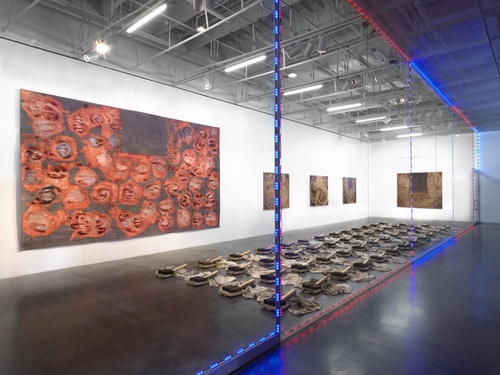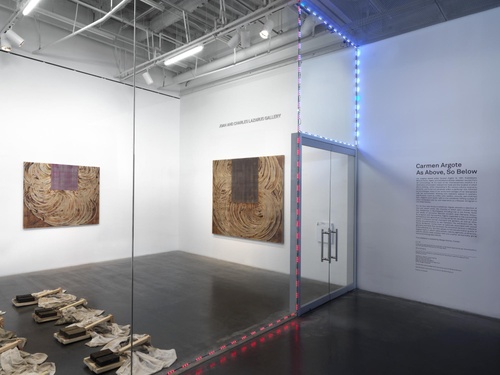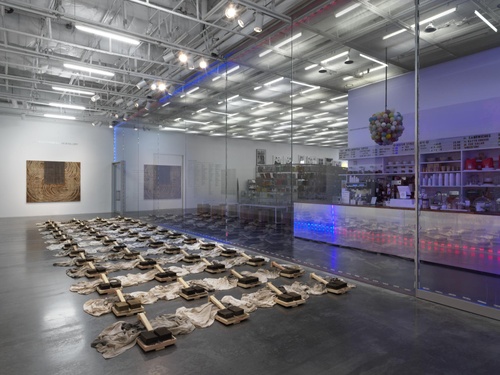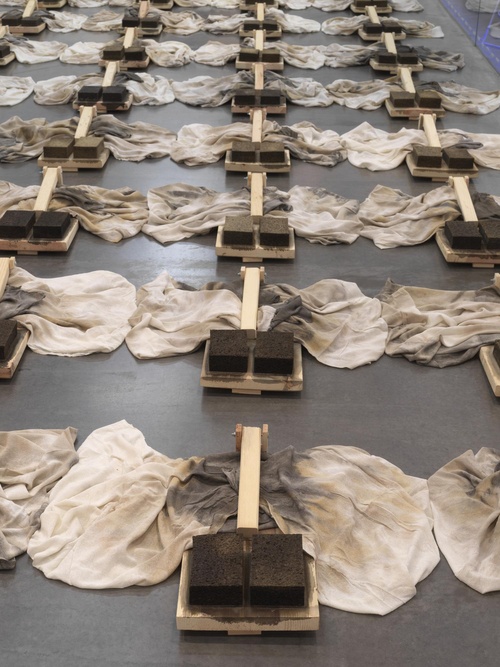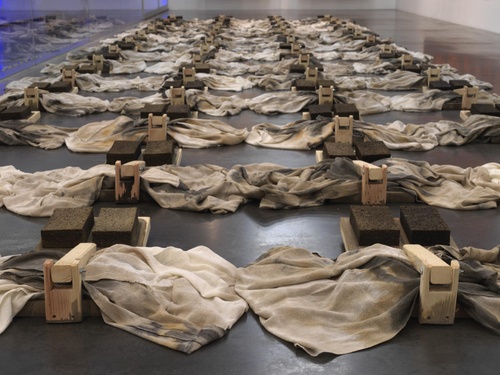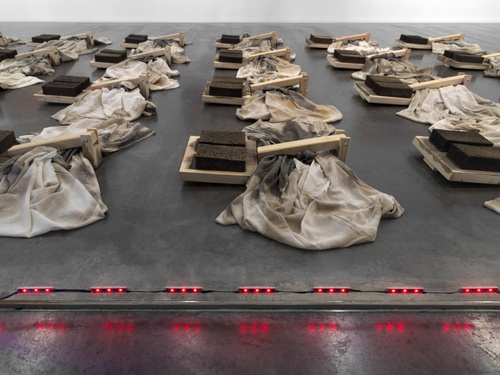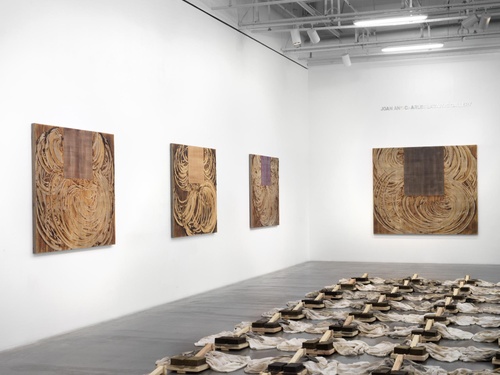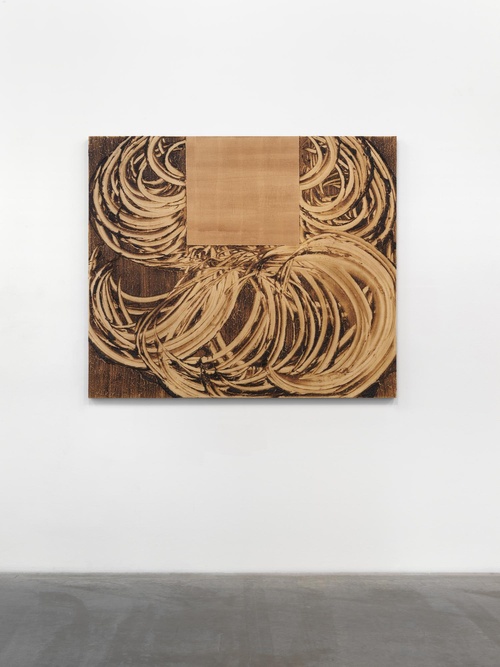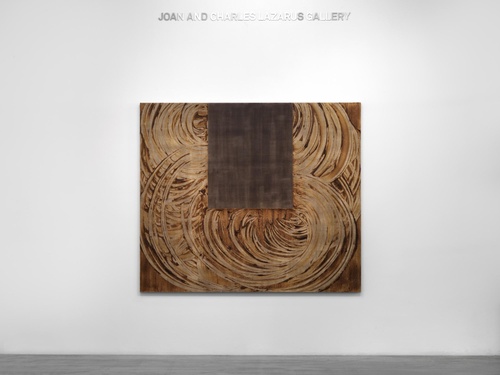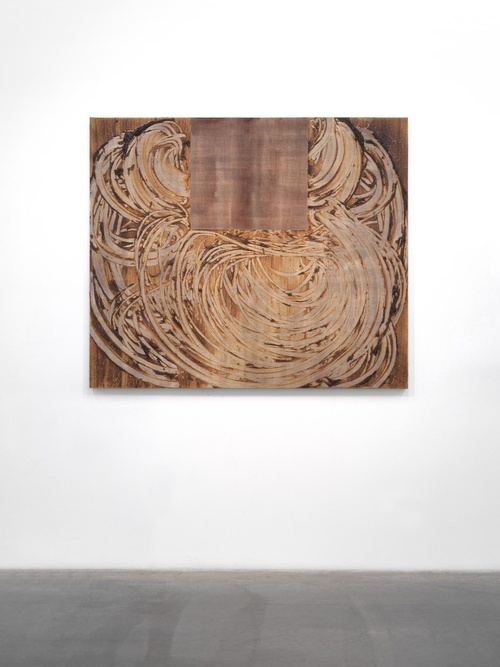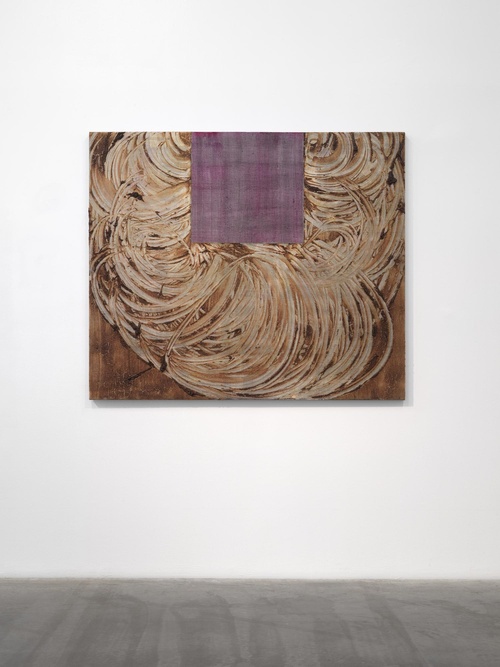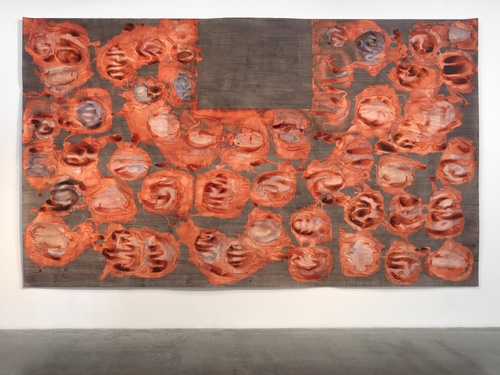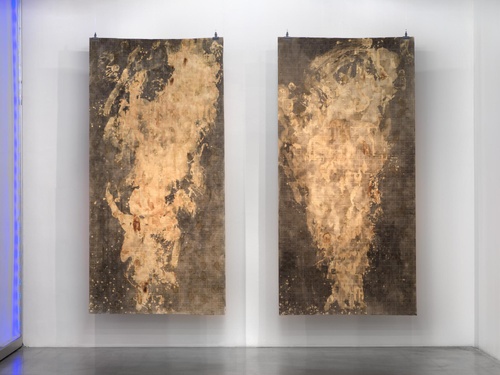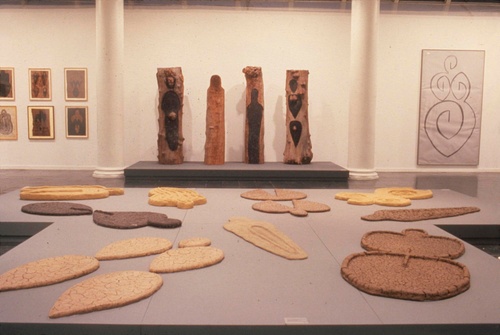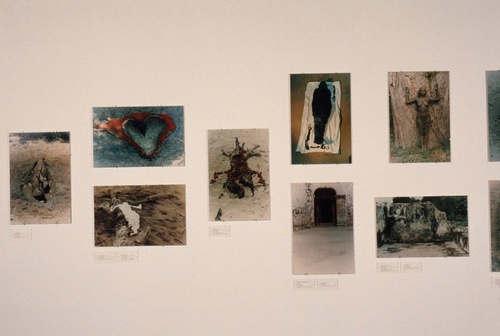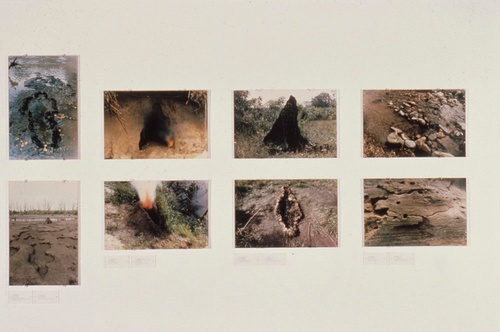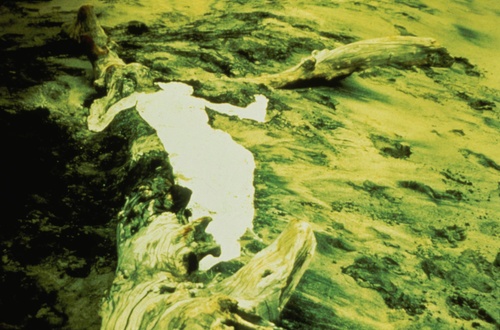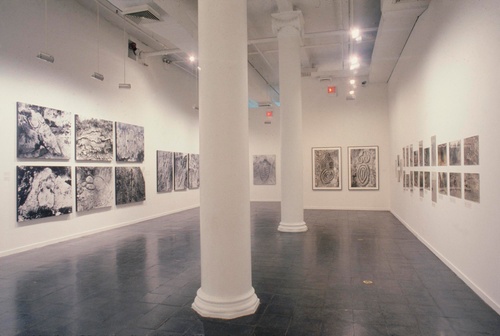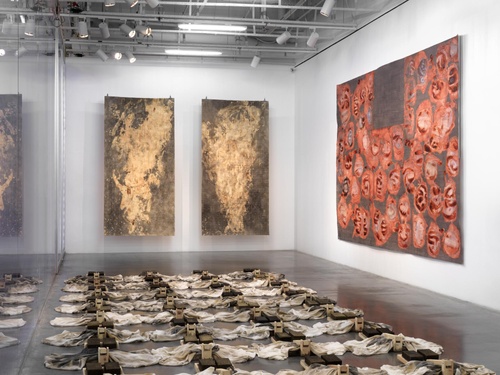Mediating Identity, Body, and Site in the Works of Carmen Argote and Ana Mendieta
ATLAS Winter 2020
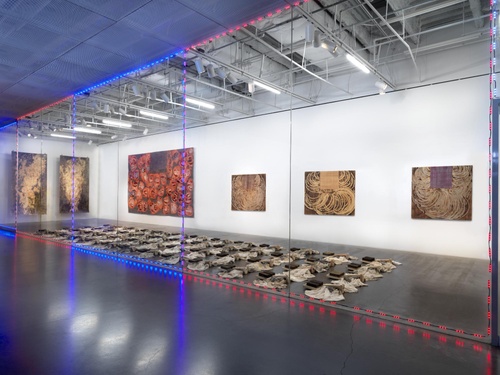
“Carmen Argote: As Above, So Below” 2019
In 2019, the New Museum presented “As Above, So Below,” the first solo museum exhibition by Mexican-American artist Carmen Argote.
The first impression of the exhibition registered from outside the Museum’s entrance on Bowery; red and blue lights were visible from the street, casting their glow from the gallery in the back of the lobby’s interior.1 The work, As Above, So Below (2019), from which the exhibition took its title, comprised LED string lights outlining the individual glass panels that separate the lobby and café from the gallery space, framing its contents like an industrial curio. With the LEDs, Argote borrowed from the visual vocabulary of the East Harlem bodegas that flanked her temporary workspace during a month-long residency preceding the exhibition. In Harlem, these “deli lights,” as the artist refers to them, project across the visual cacophony of street life, providing a focal point and frame for each shop’s wares. Argote, whose practice is rooted in processes that traverse spaces and systems, adopted this mode of display as a means of grounding the exhibition—which was largely made up of recent works produced during two consecutive residencies in Guadelajara—in its New York context.2
Upon entering the exhibition, visitors encountered Exprimidos (2019), an installation arrayed at ground level. Exprimidos, which translates to “pressed” or “pressed out,” was also created while Argote was in residence in East Harlem and, similar to As Above, So Below, draws on spatial and material elements of El Barrio, as the area is colloquially known. Arranged in rows reminiscent of New York’s street grid, each unit combines a wooden tortilla press with a sponge soaked in an avocado and iron dye and draped with a length of raw silk. The title refers to the pressing, absorption, and release of the dye, and its consequent staining of the silk, evinced in a concatenation of discrete parallel units splayed open for the viewer. By laying bare her own process and its incorporation of local materials, Argote alludes to localized forms of production and labor, and the ways in which that labor is extracted from local residents.
Argote’s appropriation of urban vernacular forms is in keeping with her interest in the spatial contours, visual elements, activities, and inhabitants of the surroundings in which she works. Many of the works on view utilized materials native to the environments in which they were created, making reference to discrete ecosystems that nonetheless contain echoes of globalized processes.
Argote describes this synthesis of external stimuli and emotional valences as a form of inhabiting, an investigation of how her body converses with specificities of site. The artist describes her practice as having developed in response to her parents’ experience as immigrants and her own transitory sense of home resulting from her father’s feelings of displacement.3 Each work contains traces of the artist’s navigations across physical space and personal memory, often informed by her dual nationality.
The exhibition’s title, “As Above, So Below,” conveys this awareness of existing between worlds. Drawing from the cosmology of Tarot, Argote takes up the mantle of the artist as “Magician,” a figure situated between planes, able to reveal truths from above and below the surface. Argote’s process is concerned with exploring this terrain through the actions and material processes she uses in her works. The planar orientation that conceptually situates the works in the exhibition is also literal—the works installed in the gallery were all created on the floor, through gestures involving contact with the ground. After developing the compositions through various lateral and downward pressing movements, Argote flipped her paintings and works on paper upright to face the viewer, presenting the terrestrial plane at eye level for contemplation.4
The surfaces of these works provide tactile evidence of Argote’s investigations. At the top of each work is a square on which the artist would position herself while she painted on the floor, allowing the composition to extend from her body outward in a series of circular, searching motions. For Argote, this process is inspired by street vendors displaying their wares to the public, a gesture which the artist perceives as both generous and practical. With her fingers, she explores and composes the surface of the painting, in a form of somatic learning and transmission.
Argote’s avocado paintings
The painting’s warm hues and matte finish are the results of natural dyes and pigments, including avocado, iron, and cochineal. The reaction of the acidic avocado pit with iron creates a warm black, whereas the cochineal’s reaction produces purple-red hues. These materials resonate with colonial and contemporary histories. Cochineal, considered precious by Pre-Columbian peoples and named for the Mesoamerican insect from which it is derived, was famously sought after by Spanish colonizers and subsequently adopted by painters across Europe.5 The recent resurgence of demand for cochineal as a natural dye to replace artificial food coloring has coincided with the popularity of contemporary “wellness culture,” which has also given rise to a global appetite for avocados, resulting in the destruction of protected woodlands and cartel violence in the Mexican state of Michoacán.6
The largest work on display, Patio con Citricos/Patio with Citrus (2019), explored similar themes though the architecture of the Museo Taller José Clemente Orozco and its environs. Responding to the citrus markets of Guadalajara and the decorative fruit trees that line the Museo’s private garden, Argote collapsed these public and private economies of consumption into a single plane. The painting is scaled in relation to the Museo’s interior atrium, and was created through a public action using one-and-a-half tons of oranges, which the artist purchased for a modest $250 USD. The cochineal layer’s vivid reaction to the citric acid of the oranges manifests in vermillion that condenses wherever the juice was spilled.
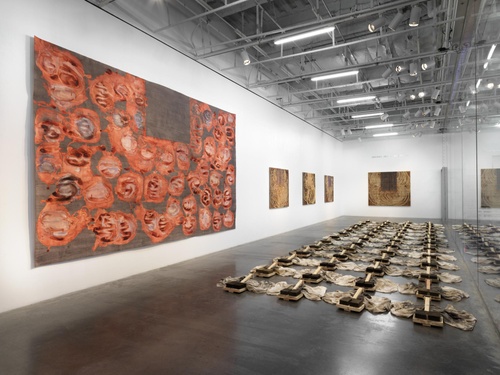
Pictured, left: Patio con Citricos / Patio with Citrus, 2019. Audio: Carmon Argote on the making of Patio con Citricos / Patio with Citrus. Excerpted from recording of Carmen Argote in Conversation with Curator Margot Norton, 2019.
The final pieces in the exhibition retranslated this alchemy of natural elements and bodily mark making in two works on paper, which were produced while Argote was in residence in Guadalajara at Taller Los Guayabos. Departing from the more gestural paintings, Argote wet the paper and used her feet to work its fibers into the tiles of the Taller’s floor, creating an impression of the grid. Argote prepared the paper with a layer of iron and tannic acid from guava leaves, then soaked herself in lemon juice to create a series of bleachlike marks where the juice reacted with the dyes; a kind of negative image generated through contact with the body.
Argote’s explorations of site and surface through the body in “As Above, So Below” recall an earlier exhibition at the New Museum of work by Cuban-American artist Ana Mendieta, which took place from 1987 to ’88. “Ana Mendieta: A Retrospective” was the artist’s first museum exhibition and the first extensive institutional investigation of the Mendieta’s life and work, which had prematurely ended with her death in 1985 when she was thirty-six.7 Co-curated by guest curators Petra Barreras del Rio, Director of El Museo del Barrio in East Harlem, and John Perreault, Director of Visual Arts at Snug Harbor Cultural Center in Staten Island, the exhibition traced Mendieta’s career through photographic documentation of site-specific works, videos of performances, and sculptures and drawings employing natural materials.
Like Argote, Mendieta’s multidisciplinary practice was informed by her immigrant experience. In September of 1961, at the age of twelve, Mendieta was sent from Havana to live in Iowa with her sister after her father joined anti-Castro counterrevolutionary forces, an action for which he was subsequently imprisoned that same year. The sisters spent this period moving between orphanages and foster homes. Though she was later reunited with her mother and father in Iowa, in 1966 and 1979, respectively, Mendieta’s experiences of exile and societal marginalization left a deep impression that would continue to inform her work throughout her career, finding particular expression in her ephemeral earth/body sculptures.8 9

In keeping with Mendieta’s use of English, Spanish, and Taíno - an extinct indigenous language native to Cuba and the Caribbean - the catalogue (pictured above) and wall text for the retrospective were also translated in both English and Spanish.
Mendieta’s earth/body sculptures, which she began making in 1973, were an outgrowth of her performance practice. In 1972, having recently completed an MA in painting, Mendieta reenrolled in the University of Iowa’s newly established Multimedia and Video Art program and began staging performances that employed provocative images and rituals that centered her body as their primary subject.10 Seeking images with power and magic, Mendieta created visceral works that saw the artist half-nude and posed as a victim of a brutal rape, writing in blood on her studio wall, standing naked with a beheaded chicken writhing in her hand, and, invoking the “white cock” of Santería fetish, soaked in blood and rolled in white feathers.11 12 Mendieta continued to expand her corporeal vocabulary, frequently performing in isolation and documenting her works through photography and film.
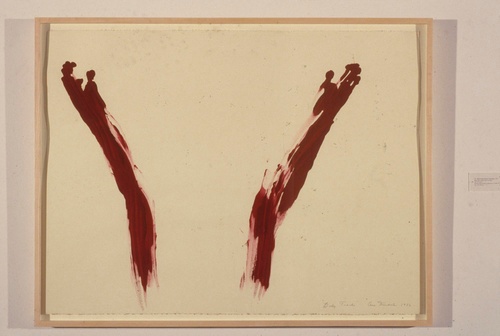
Detail of Body Tracks (Rastros corporales), 1982
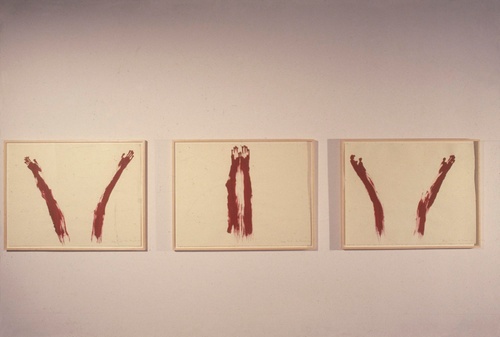
In her catalogue essay for ”Ana Mendieta: A Retrospective,” Petra Barreras del Rio observes that early works such as Blood Writing (1973) and Blood Sign No.2 (1974) can be read as prototypes of Mendieta’s 1982 body of work Body Tracks (Rastros corporales), which was included in the New Museum’s 1987 retrospective (pictured). Installation view: New Museum, New York, 1987. Photo: Fred Scruton
Mendieta’s earth/body sculptures
As her body-centered practice developed, Mendieta began what would prove to be a crucial shift in her practice: moving her work to the outdoors, in direct contact with nature. In these pieces, the outline of Mendieta’s body appears on a variety of natural surfaces through carvings and ephemeral actions, first outside Iowa City and Oaxaca, Mexico, and later in Cuba. Employing whatever natural materials were on hand, and occasionally gunpowder or fire, these earth/body sculptures bore evidence of the female body and of the labor from which they were produced, but Mendieta is largely absent, leaving an archetypal female form imprinted on the landscape in her stead. Documentation in photography and film became stand-ins for ephemeral pieces from her Silueta series (1973–80), which grew to number in the hundreds and were all left exposed to the elements and time. Mendieta would later move toward more object-based practices of carving, scorching, and drawing this iconography on tree trunks and leaves, imbuing organic materials with a psychic charge and spiritual content that exceeded the simplicity of their material supports.
Although her work from this period drew comparisons to Land artists’ use of the natural environment and documentary practices, Mendieta’s earth/body sculptures utilized a very different theoretical framework, one that took on personal and historical dimensions, which she described in an unpublished statement dating from 1981:
I have been carrying on a dialogue between the landscape and the female body (based on my own silhouette). I believe this has been a direct result of my having been torn from my homeland (Cuba) during my adolescence. I am overwhelmed by the feeling of having been cast from the womb (nature). My art is the way I re-establish the bonds that unite me to the universe. It is a return to the maternal source. Through my earth/body sculptures, I become one with the earth… . I become an extension of nature and nature becomes an extension of my body. This obsessive act of reasserting my ties with the earth is really the reactivation of primeval beliefs … [in] an omnipresent female force, the after-image of being encompassed within the womb, is a manifestation of my thirst for being.13
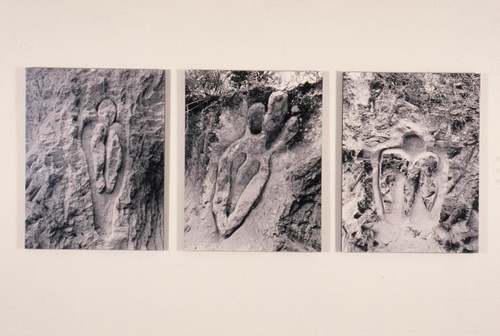
Works from the series Esculturas Rupestres (Rupestrian Sculptures), 1981
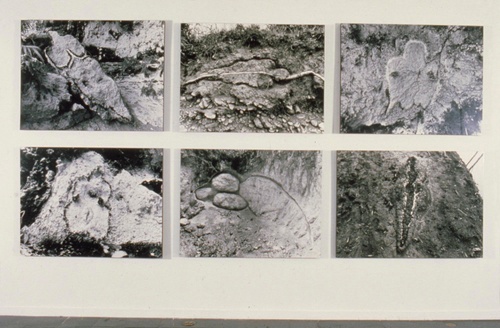
In August 1981, Mendieta returned to Cuba for the second time since her exile as a child and began a series of carvings in the caves and rock formations surrounding Jaruco, which she titled Esculturas Rupestres (Rupestrian Sculptures). Pictured: works from the series Esculturas Rupestres (Rupestrian Sculptures), 1981.
While passionately connecting the earth/body works to her own longing for her homeland, the statement also aligns Mendieta’s practices with a primordial past, situating them outside of the cultural, historical, and sociopolitical structures that had forced her into exile. Her use of contemporary media and feminist strategies emphasizing the body served to reify symbols and spiritual practices that circumvented and predated colonialism, forging alternative systems of meaning outside those dominant structures.
For Mendieta, the condition of alterity was an existential one. In the introductory catalogue essay for Dialectics of Isolation: An Exhibition of Third World Women Artists of the United States (1980), Mendieta took ownership of “Third World,” a term often applied disparagingly to women artists from Africa, Asia, and Latin America, preferring the exclusion of white patriarchal society, and its foil in the American feminist movement of the 1960’s and ’70s, to complicity in colonialism, racism and exploitation. “Do we exist?,” asks Mendieta. “To question our cultures is to question our own existence, our human reality. To confront this fact means to acquire an awareness of ourselves. This in turn becomes a search, a questioning of who we are and how we will realize ourselves.”14

Works from the series Amategram, 1981-82
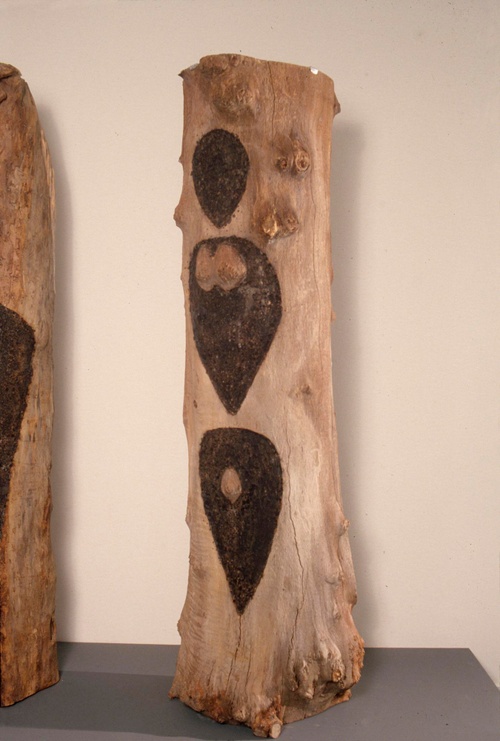
The early 1980s saw Mendieta increasingly transitioning her experiments of carving, sculpting, painting, and scorching natural materials to the indoors, particularly coinciding with her fellowship and studio at the American Academy in Rome, in 1983. Earth, sand, tree trunks, bark paper, and leaves became the support for these works, as she continued to expand her feminine iconography. Pictured: Untitled, 1985
In a 1981 talk given at the New Museum entitled “Integrity in Esthetics,” Mendieta explicitly contrasted the spiritual dimensions of her practice with imperialist subordination of nature and people, and its expression through cultural dominance. Asserting art making as a vocation, and its spiritual qualities as its greatest value to society, Mendieta described her process as one of self-knowledge in dialogue with the world, stating that “authentic cultural traditions denounce the falsehood of the ‘civilizing mission’ of the ruling class.” However,“the risk,” continued Mendieta, “is that if the cultural traditions are governed by people who are part of the ruling class, the art can become invisible because they will refuse to assimilate it.” And yet, despite this constant struggle, she contended, “The greatest comfort that great works of art give to me is not only my experience of them but also the fact that they were created and that they exist. And so, that’s proof that we will survive.”15
Though distinct in their approaches, both Mendieta and Agote’s use of natural materials and the body provide a means of searching through spaces within and beyond the dominant systems structuring existence, conjuring dimensions of identity and lived experience that might otherwise remain invisible. Informed by their respective dual nationalities, each artist’s practice explores notions of self, belonging, and home by employing improvised and embodied strategies to wield critical observations of their surroundings, while invoking an intimate emotional core. Guided by curious intellect and an attraction to mystical cosmologies, both Mendieta and Argote produced works that draw on specificities of place yet, nonetheless, hint at the universal or divine. In tracing their singular traversals of intersecting worlds and temporalities, and navigations within physical environments and social structures, these women forged powerful connections through site, material, and presence.
Amye McCarther
Archivist, New Museum of Contemporary Art
Published February 19, 2020
-
This exterior view was later occluded by the installation of Hans Haacke’s Wir (Alle) sind das Volk–We (all) are the People (2003/2017) on the New Museum’s front windows during the exhibition “Hans Haacke: All Connected.”
-
Carmen Argote, “Carmen Argote in Conversation with Curator Margot Norton,” 2019, audio recording, New Museum Digital Archive.
, September 25 2019Carmen Argote in Conversation with Curator Margot Norton
-
“My Father’s Side of Home,” Carmen Argote, accessed February 6, 2016, http://carmenargote.com/guadalajara/.
-
Carmen Argote, “Carmen Argote in Conversation with Curator Margot Norton,” 2019, audio recording, New Museum Digital Archive.
, September 25 2019Carmen Argote in Conversation with Curator Margot Norton
-
Amy Butler Greenfield, “The Bug That Had the World Seeing Red,” Smithsonian Magazine, December 29, 2016, https://www.smithsonianmag.com/innovation/bug-had-world-seeing-red-180961590/.
-
Kate Linthicum, “Inside the bloody cartel war for Mexico’s multibillion-dollar avocado industry,” Los Angeles Times, November, 21, 2019, https://www.latimes.com/world-nation/story/2019-11-20/mexico-cartel-violence-avocados.
-
New Museum, “Ana Mendieta Retrospective On View at the New Museum,” 1987, press release, New Museum Digital Archive, https://archive.newmuseum.org/print-ephemera/8854.
, 1987Press packet for “Ana Mendieta: A Retrospective” and “The Great Goddess Debate”
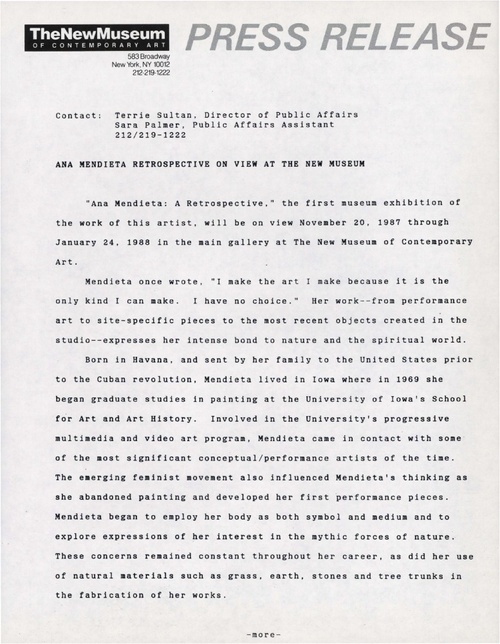
-
“Ana Mendieta,” Solomon R. Guggenheim Museum, accessed December 15, 2019, https://www.guggenheim.org/artwork/artist/Ana-Mendieta.
-
Jane Blocker, Where is Ana Mendieta: Identity, Performativity, and Exile, (Duke University: Durham and London, 1999), 54. Blocker notes that, upon arriving in the US, Mendieta’s mother was determined to obtain dual-citizenship in order to petition the US government for assistance in securing her husband’s release. Ana would later secure dual citizenship as well in order to travel more freely, allowing her to make repeated trips to Mexico, Europe, and, later, Cuba.
-
Petra Barreras del Rio, “Ana Mendieta: A Historical Overview” in Ana Mendieta: A Retrospective, exh. cat. (New Museum of Contemporary Art: New York, 1987), 28.
, 1987Ana Mendieta: A Retrospective

-
Ibid.
-
Lucy Lippard, From the Center: Feminist Essays on Women’s Art (Clark, Irwin, & Co.: Vancouver and London, 1976), 137.
-
Ana Mendieta, “unpublished statement, 1981,” in Ana Mendieta: A Retrospective, 10.
, 1987Ana Mendieta: A Retrospective

-
Ana Mendieta and Zarina Kazuko, Dialectics of Isolation: An Exhibition of Third World Women Artists of the United States (A.I.R. Gallery: New York, 1990). In the same essay, Mendieta suggests that in its efforts to deconstruct the hegemony of white male culture, American feminism had “failed to remember” women of color.
-
Ana Mendieta, “Integrity in Aesthetics,” New Museum, 1982, digitized audio recording, New Museum Digital Archive, https://archive.newmuseum.org/sounds/6670.
, February 11 1982Audio recording of “Art and Politics II: Integrity in Aesthetics” - Side one
